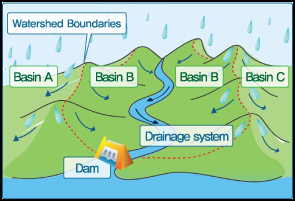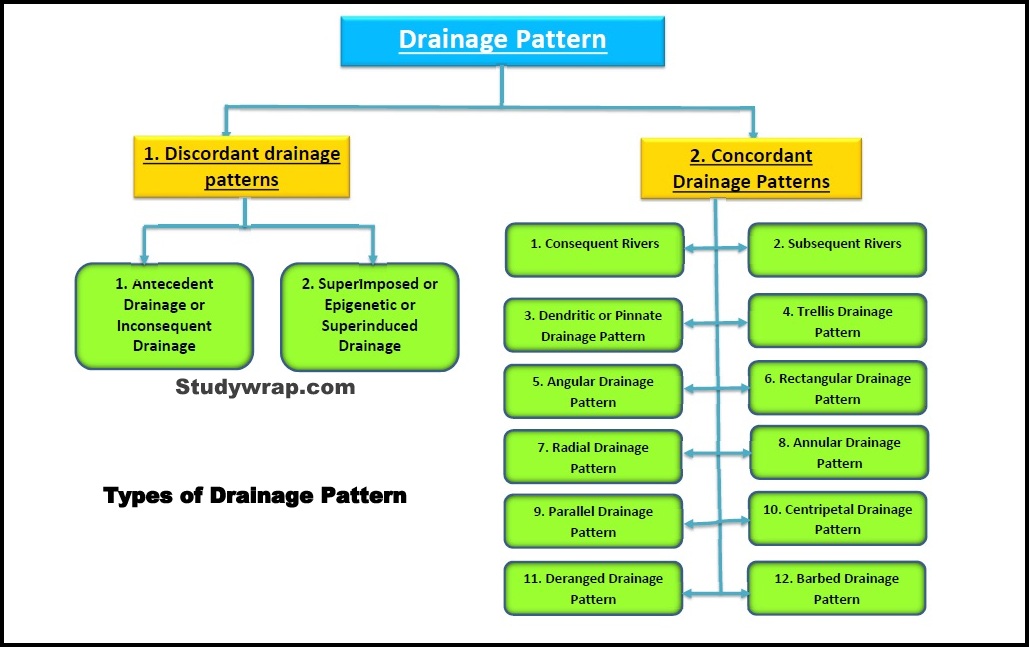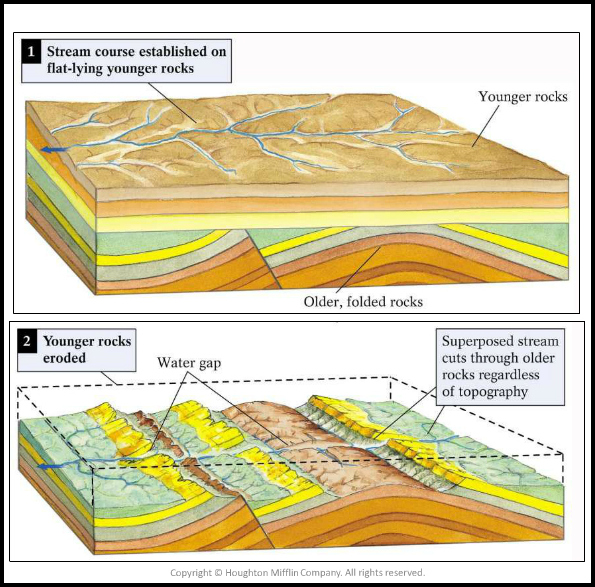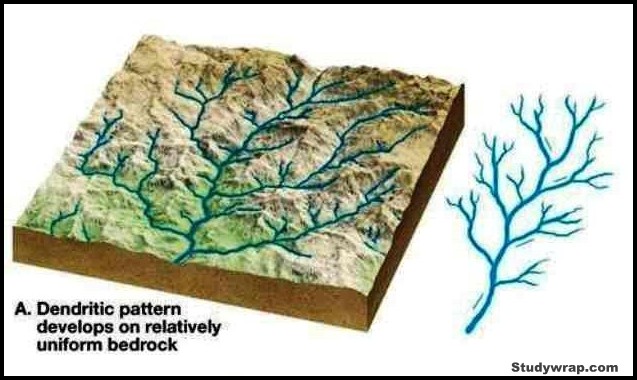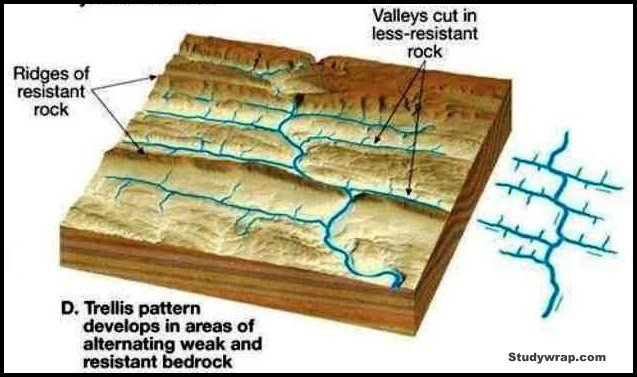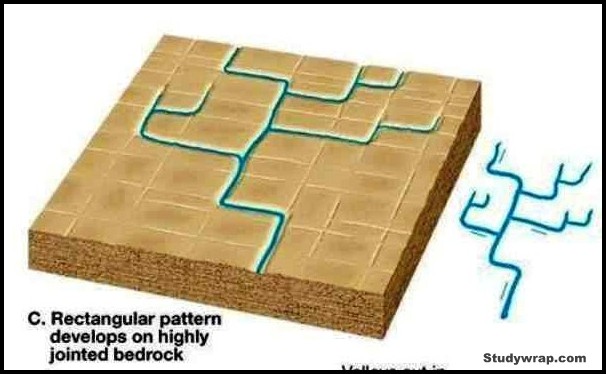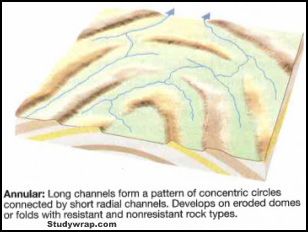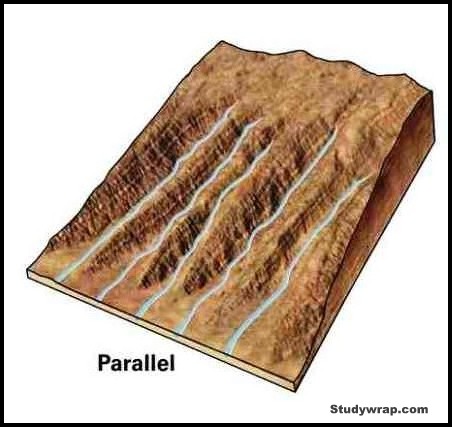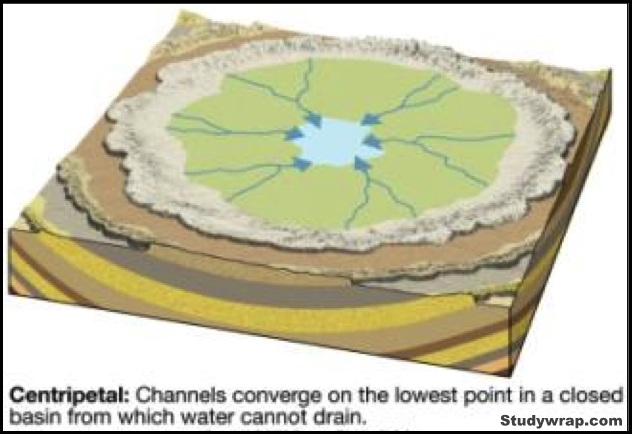Geography
Drainage System – Types of Drainage Patterns
Drainage System
Some Basic Terminologies
-
- Source of the River – The point or place from where the river emerges or starts flowing.
- Confluence – The point at which two Streams or Rivers meets or unites.
- Distributaries – When a river branches out into various small streams which do not meets in further journey. It results in decrease in volume of water flow in the main river. They are commonly found in Deltas.
- Tributary – The stream or river which originates from another source but joins a larger stream or river thus increasing the volume of water in the larger stream.
- Mouth – Point where the river meets sea or ocean.
- River Basin – All the area drained by the river and its tributaries.
- Catchment Area – All the area of land over which rain falls and is caught to serve a river basin.
- Watershed – The catchment area of large river or river basin system is called a river basin while to those of small rivers, a lake, a tank, is often referred to as watershed. Watershed are smaller in area generally less than 1000 hectares. There are many watershed within a river basin.
Eg. – Watershed of Yamuna + Watershed of Chambal + Watershed of Betwa + Watershed of Son + …. + …. + … = Drainage Basin of Ganga
-
- Water Divide – When an elevated line from where the river flows in different directions into different river basins.
- Discharge – Volume of water flowing into the river over a specific period of time. It is measured in Cusecs (Cubic feet per second) or Cumecs (Cubic meters per Second).
- River Regime – It refers to the seasonal fluctuation of the volume of water in the river.
Drainage Basin
-
- Other terms that are used to describe drainage basins are catchment, catchment area, catchment basin, drainage area, river basin, and water basin.
- The flow of water through well-defined channels is known as drainage and the network of such channels is known as drainage system.
-
- The drainage pattern of an area is the result of the geological time period, nature, and structure of rocks, topography, slope, etc.
- The drainage basin includes both the streams and rivers and the land surface.
- The drainage basin acts as a funnel by collecting all the water within the area covered by the basin and channelling it to a single point.
- The total area from where the river collects its water is known as the catchment area of that river.
- In closed (“endorheic”) drainage basins the water converges to a single point inside the basin, known as a sink, which may be a permanent lake [Lake Aral], dry lake [some desert lakes], or a point where surface water is lost underground [sink holes in Karst landforms]. Other Examples: Lake Chad [Africa], Dead Sea etc.
Drainage Divide
-
- Adjacent drainage basins are separated from one another by a drainage divide. Drainage divide is usually a ridge or a high platform.
- Drainage divide is conspicuous in case of youthful topography and it is not well marked in plains and senile topography (old featureless landforms)
Difference between a River Basin and a Watershed
-
-
- Both river basins and watersheds are areas of land that drain to a particular water body, such as a lake, stream, river or estuary.
- In a river basin, all the water drains to a large river. The term watershed is used to describe a smaller area of land that drains to a smaller stream, lake or wetland. There are many smaller watersheds within a river basin.
- Example: watershed of Yamuna + watershed of Chambal + watershed of Gandak + …. = Drainage basin of Ganga.
-
Drainage Patterns
-
- It refers to a geometric Arrangement which a river and its tributaries form together, from its source to its mouth.
- Factors that control the pattern of the drainage in a region includes –
-
-
- Topography
- Slope
- Structural control
- Nature of rocks
- Tectonic activities
- Supply of water and
- Geological history of that region.
-
-
- Based on the shape and formation of river patters, there are following types of drainage patterns.
Types of Drainage Patterns
1. Discordant Drainage Patterns
-
- A drainage pattern is described as discordant if it does not correlate to the topology and geology of the area.
- In simple words: In a discordant drainage pattern, the river follows its initial path irrespective of the changes in topography.
- Discordant Types of Drainage Patterns are classified into two main types : antecedent and superimposed.
a. Antecedent Drainage or Inconsequent Drainage
-
-
- In antecedent drainage, a river’s vertical incision (cutting or erosional) ability matches that of land uplift due to tectonic forces.
- In this type of Drainage Vertical down cutting is done by the river forming deep gorges.
- Example: Indus, Sutlej, Brahmaputra and other Himalayan rivers that are older than the Himalayas themselves. There are usually called as ANTECEDENT RIVERS.
-
b. Superimposed or Epigenetic or Superinduced Drainage
-
-
- When a river flowing over a softer rock stratum reaches the harder basal rocks but continues to follow the initial slope, the flow of the river does not seems to have any relation with the harder rock bed. This type of drainage is called superimposed drainage.
- The river flow becomes independent of present Topography. It flows in its initial paths without being influenced by changing topography.
- In other words, it is a drainage pattern which exhibits discordance with the underlying rock structure because it originally developed on a cover of rocks that has now disappeared due to denudation.
- Consequently, river directions relate to the former cover rocks and, as the latter were being eroded, the rivers have been able to retain their courses unaffected by the newly exposed structures.
- The stream pattern is thus superposed on, or placed on structural features that were previously buried.
- The Damodar, the Subarnarekha, the Chambal, the Banas and the rivers flowing at the Rewa Plateau present some good examples of superimposed drainage.
-
2. Concordant Drainage Patterns
-
- A drainage system is described as accordant if its pattern correlates to the structure and relief of the landscape over which it flows.
- In simple words: In a concordant drainage pattern, the path of the river is highly dependent on the slope of the river and topography.
- Concordant Types of Drainage Patterns are the most commonly found drainage patterns and are classified into many types –
a. Consequent Rivers
-
-
- The rivers which follow the general direction of slope are known as the consequent rivers.
- Most of the rivers of peninsular India are consequent rivers.
- For example, rivers like Godavari, Krishna and Cauvery, descending from the Western Ghats and flowing into the Bay of Bengal, are some of the consequent rivers of Peninsular India.
-
b. Subsequent Rivers
-
-
- These streams have generally developed after the original stream.
- A tributary stream that is eroded along an underlying belt of non-resistant rock after the main drainage pattern has been established is known as a subsequent river.
- Due to the northward slope of the Peninsula towards the Great Plains, the rivers originating from the Vindhyan and the Satpura ranges flow northward into the Ganga system.
- The Chambal, Sind, Ken, Betwa, Tons and Son meet the Yamuna and the Ganga at right angles. They are the subsequent drainage of the Ganga drainage system.
-
c. Dendritic or Pinnate Drainage Pattern
-
-
- In a dendritic system, there are many contributing streams (analogous to the twigs of a tree), which are then joined together into the tributaries of the main river (the branches and the trunk of the tree, respectively). They develop where the river channel follows the slope of the terrain.
- In other words, Drainage which is branching out thereby giving the appearance of a tree.
- A dendritic pattern develops in a terrain which has uniform lithology, and where faulting and jointing are insignificant.
- Most of the rivers of the Indo-Gangetic Plains are of dendritic type.
- Examples: Indus, Godavari, Mahanadi, Cauvery, Krishna.
-
d. Trellis Drainage Pattern
-
-
- It is a type of rectangular pattern formed where two sets of structural controls occurs at right angles.
- In this type of pattern the short subsequent streams meet the main stream at right angles and differential erosion through soft rocks paves the way for tributaries.
- Trellis drainage patterns typically develop where sedimentary rocks have been folded or tilted and then eroded to varying degrees depending on their strength.
- Examples: The old folded mountains of the Singhbhoomi (Chhotanagpur Plateau).
-
e. Angular Drainage Pattern
-
-
- Angular drainage patterns form where bedrock joints and faults intersect at more acute angles than rectangular drainage patterns.
- The tributaries join the main stream at acute angles or at obtuse angles.
- This pattern is common in Himalayan foothill regions.
-
f. Rectangular Drainage Pattern
-
-
- The drainage pattern marked by right-angled bends and right-angled junctions between tributaries and the main stream is known as rectangular drainage.
- The main stream bends at right angles and the tributaries join at right angles creating rectangular patterns.
- It differs from the trellis pattern in so far as it is more irregular and its tributary streams are neither as long, nor parallel as in trellis drainage.
- Example: streams found is the Vindhyan Mountains of India.
-
g. Radial Drainage Pattern
-
-
- The radical pattern develops when streams flow in different directions from a central peak or dome like structure.
- The tributaries from a summit follow the slope downwards and drain down in all directions.
- Examples: Streams of Saurashtra region, Central French Plateau, Mt. Kilimanjaro.
- A good example of a radial drainage pattern is provided by the rivers originating from the Amarkantak Mountain.
- Rivers like Narmada, Son and Mahanadi originating from Amarkantak Hills flow in different directions and are good examples of radial pattern.
- Radial drainage patterns are also found/in the Girnar Hills (Kathiawar, Gujarat), and Mikir Hills of Assam.
-
h. Annular Drainage Pattern
-
-
- In this drainage pattern, the subsequent streams follow curving or actuate courses prior to joining the consequent stream. The subsequent streams find it easier to erode the concentric, less resistant strata.
- In an annular drainage pattern streams follow a roughly circular or concentric path along a belt of weak rock, resembling in plan a ring like pattern.
- In other words, when the upland has an outer soft stratum, the radial streams develop subsequent tributaries which try to follow a circular drainage around the summit.
- Example: Black Hill streams of South Dakota.
- This is not a very common drainage pattern in India. Some examples of this are however found in Pithoragarh (Uttarakhand), Nilgiri Hills in Tamil Nadu and Kerala.
-
i. Parallel Drainage Pattern
-
-
- A parallel drainage system is a pattern of rivers caused by steep slopes with some relief. Because of the steep slopes, the streams are swift and straight, with very few tributaries, and all flow in the same direction.
- The tributaries seem to be running parallel to each other in a uniformly sloping region.
- Example: Rivers of lesser Himalayas and The small and swift rivers originating in the Western Ghats that flow into Arabian Sea.
-
j. Centripetal Drainage Pattern
-
-
- In a low lying basin the streams converge from all sides.
- The centripetal drainage system is similar to the radial drainage system, with the only exception that radial drainage flows out versus centripetal drainage flows in.
- Examples: streams of Ladakh, Tibet, and the Baghmati and its tributaries in Nepal.
-
k. Deranged Drainage Pattern
-
-
- This is an uncoordinated pattern of drainage characteristic of a region recently vacated by an ice-sheet.
- It happens in areas where there has been much geological disruption.
- This type of drainage is found in the glaciated valleys of Karakoram.
-
l. Barbed Drainage Pattern
-
-
- A pattern of drainage in which the confluence of a tributary with the main river is characterized by a discordant junction—as if the tributary intends to flow upstream and not downstream.
- This pattern is the result of capture of the main river which completely reverses its direction of flow, while the tributaries continue to point in the direction of former flow.
- The Arun River (Nepal), a tributary of the Kosi is an interesting example of barbed drainage pattern.
-
So, this was all about the types of Drainage Patterns.
In the next post (Click here), we would start a new topic that is Drainage System of India.


